Mayan Cichlid, Mayaheros urophthalmus
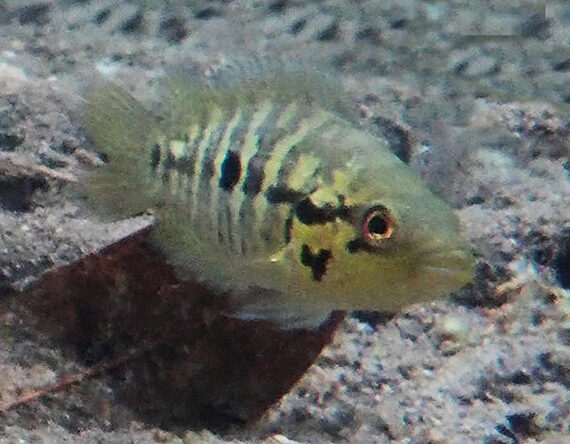 Mayan Cichlid, Mayaheros urophthalmus, Juvenile. Underwater photograph taken within the within the Sian Ka’an Biosphere Reserve, Quintana Roo, March 2021. Photograph courtesy of Marina Sutormina, Stockholm, Sweden.
Mayan Cichlid, Mayaheros urophthalmus, Juvenile. Underwater photograph taken within the within the Sian Ka’an Biosphere Reserve, Quintana Roo, March 2021. Photograph courtesy of Marina Sutormina, Stockholm, Sweden.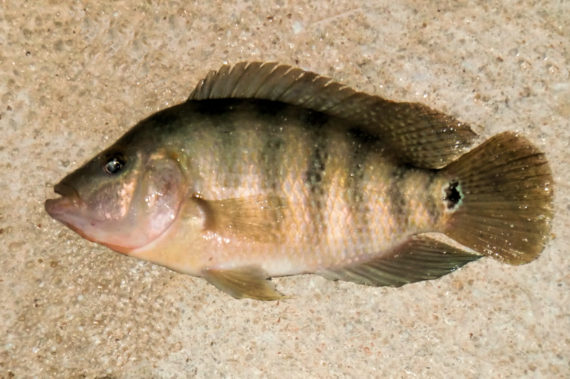 Mayan Cichlid, Mayaheros urophthalmus. Fish caught out of a garden pond within the Grand Mayan Riviera Maya property, Cancun, Quintana Roo, April 2012. Length: 15 cm (5.9 inches). Catch, photograph and identification courtesy of George Brinkman, Guelph, Ontario, Canada.
Mayan Cichlid, Mayaheros urophthalmus. Fish caught out of a garden pond within the Grand Mayan Riviera Maya property, Cancun, Quintana Roo, April 2012. Length: 15 cm (5.9 inches). Catch, photograph and identification courtesy of George Brinkman, Guelph, Ontario, Canada.
 Mayan Cichlid, Mayaheros urophthalmus. Fish caught from brackish coastal waters off Cancun, Quintana Roo, January 2016. Length: 16 cm (6.3 inches). Catch, photograph and identification courtesy of Nick Morenc, Mission Viejo, California.
Mayan Cichlid, Mayaheros urophthalmus. Fish caught from brackish coastal waters off Cancun, Quintana Roo, January 2016. Length: 16 cm (6.3 inches). Catch, photograph and identification courtesy of Nick Morenc, Mission Viejo, California.
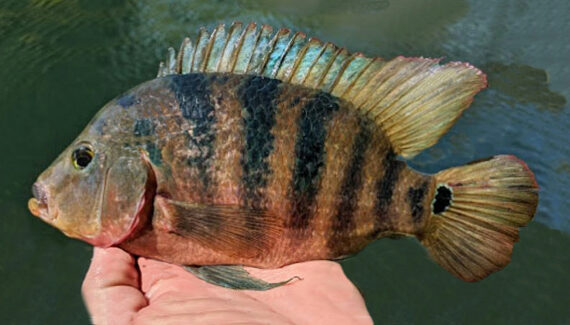 Mayan Cichlid, Mayaheros urophthalmus. Fish caught from brackish waters within Coral Reef Park, Palmetto Bay, Florida, February 2020. Length: 16 cm (6.3 inches). Catch, photograph and identification courtesy of Marc Eberlein, Grand Rapids, Michigan.
Mayan Cichlid, Mayaheros urophthalmus. Fish caught from brackish waters within Coral Reef Park, Palmetto Bay, Florida, February 2020. Length: 16 cm (6.3 inches). Catch, photograph and identification courtesy of Marc Eberlein, Grand Rapids, Michigan.
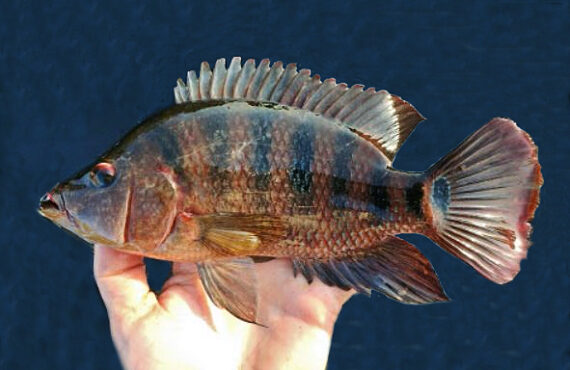 Mayan Cichlid, Mayaheros urophthalmus. Fish caught from brackish waters within Coral Reef Park, Palmetto Bay, Florida, February 2020. Length: 16 cm (6.3 inches). Catch, photograph, and identification courtesy of Josh Leisen (joshadventures.com), Gaylord, Michigan.
Mayan Cichlid, Mayaheros urophthalmus. Fish caught from brackish waters within Coral Reef Park, Palmetto Bay, Florida, February 2020. Length: 16 cm (6.3 inches). Catch, photograph, and identification courtesy of Josh Leisen (joshadventures.com), Gaylord, Michigan.
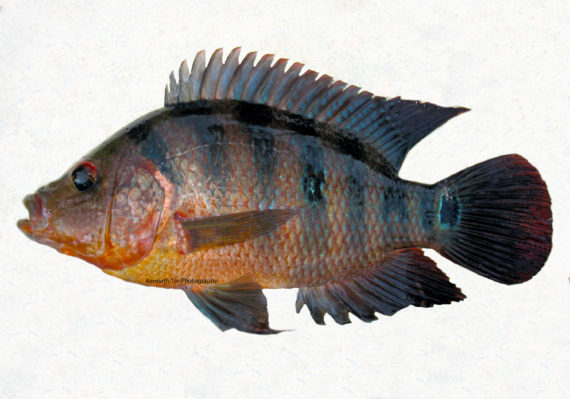 Mayan Cichlid, Mayaheros urophthalmus. Fish caught in Tamiami Canal within the Big Cypress National Reserve in South Florida, December 2013. Length: 23 cm (9.0 inches). Catch, photograph and identification courtesy of Kenneth Tse, Toronto, Ontario, Canada.
Mayan Cichlid, Mayaheros urophthalmus. Fish caught in Tamiami Canal within the Big Cypress National Reserve in South Florida, December 2013. Length: 23 cm (9.0 inches). Catch, photograph and identification courtesy of Kenneth Tse, Toronto, Ontario, Canada.
The Mayan Cichlid, Mayaheros urophthalmus, is a member of the Cichlid and Tilapia or Cichilidae Family, that is also known as the Mexican Mojarra and in Mexico as castarrica. The Mayan Cichlid was recently reclassified from Cichlasoma urophthalmus to Mayaheros urophthalmus. Some believe that there as many as eighteen different subspecies of Mayan Cichlid. Globally, there are thirteen species in the genus Mayaheros, of which twelve are found in the freshwater systems of Mexico’s Atlantic Slope.
The Mayan Cichlid has an oval compressed body that is similar in shape to elongated bluegills. They have a yellow to olive-brown body with 5 to 7 distinct vertical green-black bars and a prominent black ocellus surrounded by a blue ring at the base of their caudal fin. The colors are more intense in breeding fish and fish caught in the wild. They are sexually dimorphic with males being are slightly larger than females but dichromatic with the males and females having similar colors. They have small eyes located high on their head and a small slightly protrusible terminal mouth with three rows of teeth on both their upper and lower jaws. The anal fin has 6 or 7 spines with 6 to 10 rays; the caudal fin is rounded; the dorsal fin has 15 to 17 spines and 10 to 12 rays; and the pelvic fins are posterior to the pectoral fins. They have 9 to 11 flat short gill rakers and they are covered with scales.
The Mayan Cichlid is a coastal resident found in lakes, rivers, rocky shorelines, lagoons, estuaries, coastal islands, mangrove swamps, and turtle grass flats in both fresh and brackish waters. They reach a maximum length of 39 cm (15 inches) but are more common between 25 cm (10 inches) and 28 cm (11 inches) and 1.1 kg (2.4 lbs) in weight. As of January 1, 2024, the International Game Fish Association world record stood at 1.36 kg (3 lbs 0 oz) with the fish caught in a Florida Lake in September 2016. They prefer oxygen-rich waters in and around submerged vegetation and over muddy bottoms. They are capable of surviving extreme hypoxia (low levels of blood oxygen) and are euryhaline exhibiting a tolerance and affinity for brackish to marine conditions, including the ability to reproduce in waters with salinity from 0 to 40 ppt. They are found in the wild in waters between 18oC (64oF) and 34oC (93oF). They cannot survive in waters that are below 14oC (57oF). They are philopatric, site-tenacious, and non-migratory with a limited home range. They are omnivores that feed predominantly on small fish but supplement their diet with algae, crustaceans, detritus, gastropods, aquatic insects, and wading birds. They are monogamous substrate-spawners that become highly territorial and very aggressive when breeding. They spawn continually, with several broods per year, when water temperatures are above 24oC (75oF). Adhesive eggs number 100 to 600 per brood and are cared for by both parents with great diligence for up to 6 weeks. The hatched eggs immediately relocate to the bottom and attach themselves to plant materials for about a week before becoming free swimming. They have a lifespan of up to seven years in the wild and up to eleven years in captivity.
The Mayan Cichlid is found within all of the freshwater drainage systems of the Atlantic Ocean including the Gulf of Mexico and the Yucatán Peninsula in the Caribbean.
The Mayan Cichlid is easily confused with the Red Terror Cichlid, Cichlasoma festae (larger; shorter snout; bulging forehead; longer trailing anal and dorsal fins; 9 dark bands on sides).
From a conservation perspective the Mayan Cichlid has not been formally evaluated but they should be considered to be of Least Concern with increasing widely distributed populations. They are targeted by artisanal fishermen for food and by recreational fishermen for their aggressiveness and strength when hooked. Some recreational anglers consider them pests. They are also raised in aquaculture facilities in Mexico primarily for food. Due to their beautiful colors and patterns and their complex behavioral patterns, this species is also used in the aquarium trade, however, they are only suitable for aquariums that hold at least 220 liters (55 gallons) and require special handling and high maintenance, due to their large size and very aggressive behavior. Non-indigenous populations of the Mayan Cichlid were first report in southern Florida in 1983 where they are now well-established and spreading rapidly northward. These introductions are believed to have originated via aquarium releases or fish farm escapes. As they are voracious predators they have the potential of becoming one of the most damaging introduced cichlids in the United States.